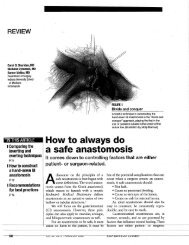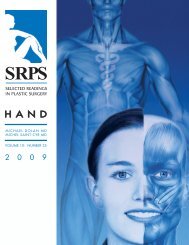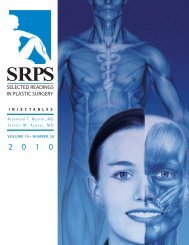Craniofacial Anomalies, Part 2 - Plastic Surgery Internal
Craniofacial Anomalies, Part 2 - Plastic Surgery Internal
Craniofacial Anomalies, Part 2 - Plastic Surgery Internal
You also want an ePaper? Increase the reach of your titles
YUMPU automatically turns print PDFs into web optimized ePapers that Google loves.
tosis usually have normal mental development, but<br />
the proportion of normal children decreases with<br />
age, particularly for children with multisuture synostosis<br />
displaying brachycephaly and oxycephaly. 200 On<br />
the basis of their studies, the authors recommend<br />
early surgery, as there is no reliable way to distinguish<br />
which infants will not have problems from craniosynostosis.<br />
201,202<br />
Kapp-Simon and colleagues, 203 on the other hand,<br />
longitudinally examined the mental development of<br />
infants before and after cranial release, and compared<br />
it with that of infants who were not surgically<br />
treated. The authors concluded that cranial release<br />
and reconstruction did not affect mental development<br />
either positively or negatively. Renier and<br />
Marchac, 204 in a commentary of the above paper,<br />
strongly dispute this finding and state that the number<br />
of patients in Kapp-Simon’s study was too small<br />
to warrant any conclusions.<br />
Subsequently Kapp-Simon 205 published her analysis<br />
of a series of 84 patients with single suture synostosis<br />
followed longitudinally for >1y and reported a mental<br />
retardation rate of 6.5%, which is 2–3X the normal.<br />
Almost half the children who were of school<br />
age displayed some type of learning disorder. More<br />
importantly, these results were independent of early<br />
surgical correction, discounting the hypothesis that<br />
early correction of craniosynostosis would improve<br />
mental function. Similarly, Virtanen 206 found that<br />
the neurocognitive performance of children with craniosynostosis<br />
did not reach that of matched normal<br />
controls, suggesting the impairment of brain function<br />
had already taken place in utero.<br />
Gault et al 207 attempted to correlate elevations of<br />
intracranial pressure with decreases in intracranial<br />
volume as measured by CT. They found no direct<br />
relationship between the two on measurement of<br />
104 children with craniosynostosis. 202 It appears that<br />
decreased intracranial volume alone is not adequate<br />
justification for surgery in cranisynostosis. 208<br />
Posnick and colleagues 209 demonstrated that true<br />
measurements of intracranial volume can be obtained<br />
indirectly using CT scans. Premature closure of either<br />
the sagittal or metopic suture does not result in<br />
diminished intracranial volume. This was confirmed<br />
in long-term follow-up by Polley, 210 who showed<br />
that craniofacial procedures can be relied upon to<br />
increase the intracranial volume. Polley also found<br />
that long-term normative intracranial volume was<br />
maintained postoperatively, and hypothesized that<br />
SRPS Volume 10, Number 17, <strong>Part</strong> 2<br />
although normal volumes are seen pre- and postoperatively<br />
in craniosynostosis, reconfiguration of the<br />
skull dimensions in the region of the synostosed suture<br />
may be beneficial.<br />
David et al 211 adds further support to this theory<br />
in a study of cerebral perfusion pre- and postoperatively,<br />
where they found cerebral perfusion defects<br />
preoperatively in the area of the fused suture that<br />
were corrected following surgery. In cases of complex<br />
craniosynostosis, abnormalities of venous drainage<br />
at the level of the skull base produce venous<br />
hypertension and subsequent raised ICP. 212 Most<br />
surgeons therefore operate on infants at age 6–9<br />
months, and even earlier in severe cases.<br />
Cohen 213 reviews the evidence and concludes that<br />
differences in methods of pressure measurement,<br />
patient selection, and the lack of normative data<br />
make interpretation of existing studies difficult. He<br />
suggests that a clinical awareness of the signs of raised<br />
ICP is essential, though in cases of moderate deformity<br />
and no signs of raised ICP, close follow-up is<br />
applicable.<br />
Neuropsychiatric disorders range from mild<br />
behavioral disturbances to overt mental retardation<br />
possibly secondary to cerebral compression. The<br />
abnormally shaped skull also imposes psychological<br />
considerations that can be severe and should not be<br />
underestimated. Barritt and associates 214 report that<br />
children with untreated scaphocephaly are teased<br />
and taunted at school for their head shape, which<br />
compounds their slow learning and poor motor skills.<br />
Arndt and others 215 and Pertschuk and Whitaker 216<br />
studied the psychosocial adjustments of children to<br />
the correction of a deformity by craniofacial surgery.<br />
The authors noted increased self-esteem and adaptive<br />
functioning along with a decrease in hyperactive<br />
behavior and inhibited attitude, peaking at 1 year<br />
postoperatively. Despite cosmetic improvements and<br />
lower anxiety levels, however, social interactions were<br />
not helped by the surgery. Likewise, Ousterhout<br />
and Vargervik 217 noted normalization of anthropometric<br />
points on CT scan of children who underwent<br />
Le Fort III and genioplasty because of craniosynostosis,<br />
but the degree of postoperative change did not<br />
equate with attractiveness.<br />
In another study, Barden and colleagues 218,219<br />
looked at changes in physical attractiveness as well as<br />
emotional and behavioral reactions of children before<br />
and after craniofacial surgery. Their findings suggest<br />
17






